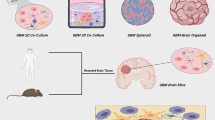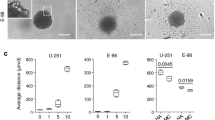Abstract
The C6 spheroid implantation glioma model is a simple, easily reproduced model for primary gliomas in which C6 astrocytoma cells are grown in vitro as spheroids and subsequently implanted into the brains of Sprague Dawley rat hosts. This report describes the growth, histology, vessel architecture and vascular permeability of the resulting tumors. The appearance of the tumor was investigated by light and electron microscopy, and by using the alkaline phosphatase technique. The leakage of tracer was measured from vessels in the tumor and peritumoral area at various times during tumor development. The spheroid implant produces a fully vascularized, rapidly growing tumor with many of the characteristics of glioblastoma multiforme, from an avascular focus of neoplastic cells. The major advantage of this model is that the tumors grow in a spheroidal fashion and the tumor-brain interface can be easily located. Many of the important events in the process of vascularization take place at the tumor-brain interface. Two distinctive vascular events appear to occur simultaneously: 1) proliferation of blood vessels and their growth into the tumor mass so that they develop into typical, permeable tumor vessels, and 2) migration of tumor cells along normal vessels into the surrounding brain. Tumor vessels were permeable to the tracer Evans Blue (EB) from the earliest days of ingrowth. Leakage of the EB increased as the tumors increased in size, but eventually leakage plateaued as tumors developed necrotic centers. II is well known that the structural and permeability characteristics of vessels associated with the tumor affect tumor growth. This model will be useful for a number of proposed studies including assessment of various clinical therapies on tumor growth and development, and more specifically, quantitative analysis of the vascularization process in tumors.
Similar content being viewed by others
References
Bigner DD, Svwenberg JA: Experimental Tumors of the Central Nervous System. First English Edition, UpJohn, 1977.
Auer R, Del Maestro RF, Anderson R: A simple and reproducible experimental in vivo glioma model. Can J Neurol 8:325–331, 1981.
Wassenaar W, Tator CM, So WS: The development of an intracerebral glioma model for brain tumor chemotherapy. J Neurosurg 39:293–301, 1973.
Groothius DR, Fischer J, Vick NA, Bigner DD: Comparative permeability of different glioma models to horseradish peroxidase. Cancer Treat Rep (suppl 2):13–18, 1981.
Hurter T, Mennel HD: Experimental brain tumors and edema in rats. Acta Neuropathol 55:105–111, 1981.
Groothius DR, Fischer JM, Lapin G, Bigner DD, Vick NA: Permeability of different experimental brain tumor models to horseradish peroxidase. J Neuropathol Expl Neurol 41:164–185, 1982.
Blasberg RG, Molnar F, Horowitz M, Kornblith P, Pleasants R, Fenstermacher J: Regional blood flow in RT- 9 brain tumors. J Neurosurg 58:863–873, 1983.
Del Maestro RF, Stroud E: Growth of multicell spheroids from experimental and human glial tumors (abs) Can J Neurol Sci 10:155, 1983.
Benda P, Lightbody J, Sato G, Levine L, Sweet W: Differentiated rat glial cell strain in tissue culture. Science 161:370–371, 1968.
Sutherland RM, McCredie JA, Inch WR: Growth of multicell spheroids in tissue culture as a model of nodular carcinomas. J Natl Cancer Inst 46:113–120, 1971.
Bell MA, Scarrow WG: Staining for microvascular alkaline phosphatase in thick celloidin sections of nervous tissue: Morphometric and pathological applications. Microvasc Res 27:189–203, 1984.
Durward QJ, Del Maestro RF, Amacher AL, Farrar JK: The influence of systemic arterial pressure and intracranial pressure on the development of cerebral vasogenic edema. J Neurosurg 59:938–944, 1983
Folkman J, Merler E, Abernathy C, Williams G: Isolation of a tumor factor responsible for angiogenesis. J Expl Med 133:275–288, 1971.
Folkman J, Langer R, Lindardt RJ, Haudenschild C, Taylor S: Angiogenesis inhibition and tumor regression caused by heparin or a heparin fragment in the presence of cortisone. Science 221:719–725, 1983.
Langer R, Conn H, Vacanti J, Haudenschild C, Folkman J: Control of tumor growth in animals by infusion of an angiogenesis inhibitor. Proc Natl Acad Sci 77:4331–4335, 1980.
Deane BR, Lantos PL: The vasculature of experimental brain tumors. J Neurol Sci 49:67–77, 1981.
Waggener JD, Beggs JL: Vasculature of neural neoplasms. Adv Neurol 34:27–29, 1976.
Westergaard E: Ultrastructural permeability properties of cerebral microvasculature under normal and experimental conditions. J Natl Cancer Inst 53:1229–1240, 1974.
Stewart PA, Hayakawa K, Hayakawa E, Farrell CL, Del Maestro RF: Quantitative study of blood-brain barrier permeability ultrastructure in a new rat glioma model. Acta Neuropathol (Berl) 67:96–102, 1985
Brem S, Cotran R, Folkman J: Tumor angiogenesis: A quantitative method for histologic grading. J Natl Cancer Inst 48:347–356, 1972.
Potter RF, Groom AC: Capillary diameter and geometry in cardiac and skeletal muscle studied by means of corrosion casts. Microvasc Res 25:68–84, 1983.
Saunders RL deCH: The application of microfocal radiography to neuroanatomy and neuropathology research, and its relation to cerebral angiography and brain scan interpretation. In: Ely RV (ed) Microfocal Radiography, London, Academic Press, 1980, pp 84–144.
Bar TH: Patterns of vascularization in the developing cerebral cortex of rat. In: Ciba Foundation (ed) Development of the Vascular System, Pitman, London, 1983, pp 20–32.
Pakula H, Minnel HD, Zulch KJ: Gross vascularization of experimentally induced transplanted tumors of the central and peripheral nervous system. Acta Neuropathol 43:185–190, 1978.
Bell MA, Ball MJ: Morphometric comparison of hippocampal microvasculature in ageing and demented people: diameters and densities. Acta Neuropathol 53:299–318 1981.
Romanul FA, Bannister RG: Localized areas of high alkaline phosphatase activity in the terminal arterial tree. J Cell Biol 15:73–84, 1962.
Lossinsky AS, Vorbrot AW, Wisnieuwski HM: Ultracyfochemical studies of vesicular transport structures in the injured mammalian blood-brain barrier. Acta neuropathol (Berl) 61:239–245, 1983.
Cox DJ, Pilkingtom GJ, Lantos PL: The fine structure of blood vessels in ethylnitrosourea-induced tumors of the rat nervous system. With special reference to the breakdown of the blood-brain barrier. Br. J. Pathol 57:419–430, 1976.
Nisho S, Ohata M, Abe M, Kitamura K: Microvascular abnormalities in ethylnitrosourea (ENU)-induced rat brain tumors: Structural basis for altered blood-brain barrier function. Acta Neuropathol 59:1–10, 1983.
Yamada, K, Hayakawa T, Ushio Y, Arita N, Kato A, Mogami H: Regional blood flow and capillary permeability in the ethylnitrosourea-induced rat glioma. J Neurosurg 55:922–928, 1981.
Castejon DJ: Electron microscopic study of capillary wall in human cerebral edema. J Neuropath Exp Neurol 39:296–328, 1980.
Reichman H, Farrell CL, Del Maestro RF: The effects of steroids and non-steroidal anti-inflammatory agents on vascular permeability in the spheroid implantation rat glioma model. J Neurosurg 65: 233–237, 1986.
Author information
Authors and Affiliations
Rights and permissions
About this article
Cite this article
Farrell, C.L., Stewart, P.A. & Del Maestro, R.F. A new glioma model in rat: The C6 spheroid implantation technique permeability and vascular characterization. J Neuro-Oncol 4, 403–415 (1987). https://doi.org/10.1007/BF00195612
Issue Date:
DOI: https://doi.org/10.1007/BF00195612




